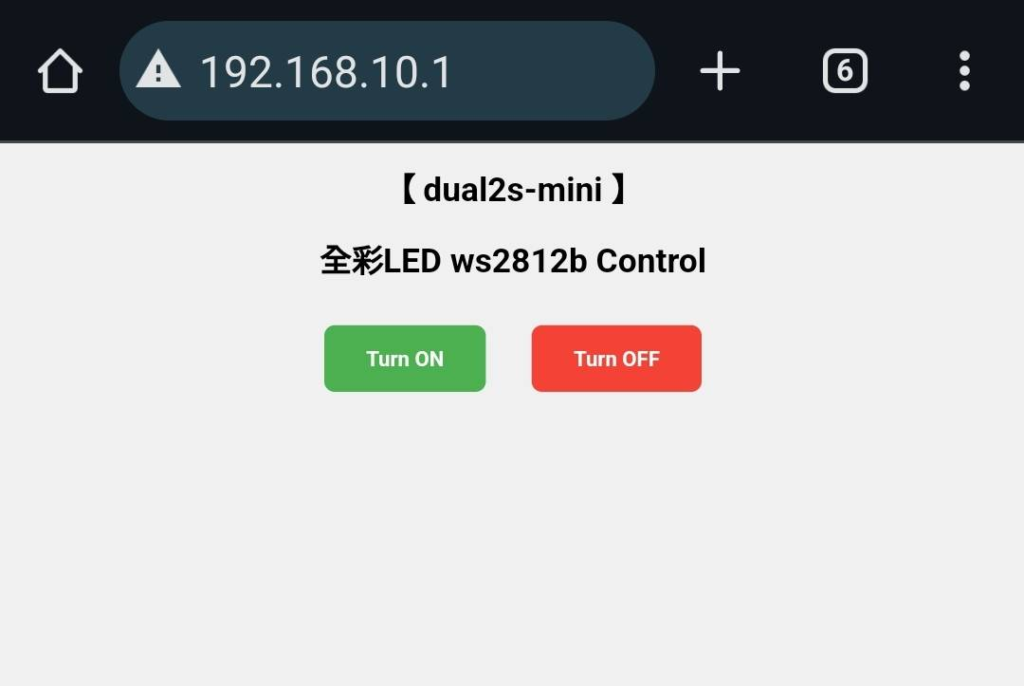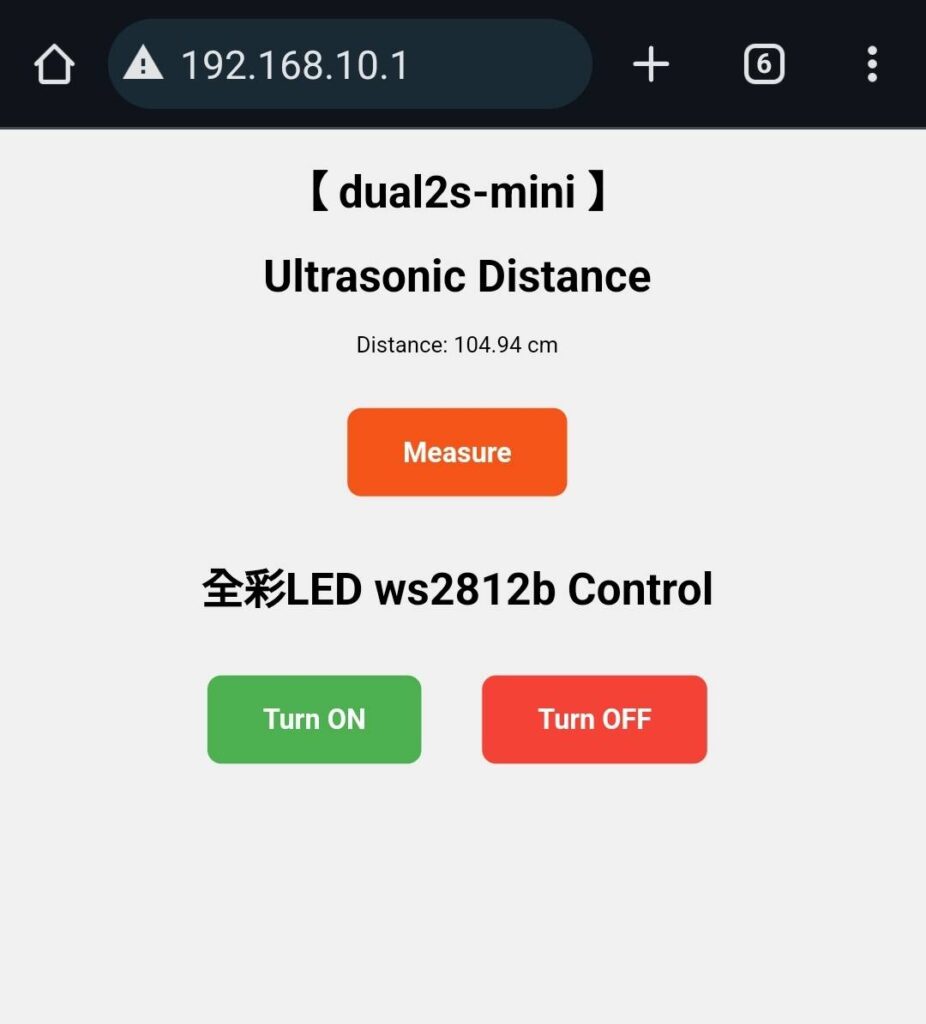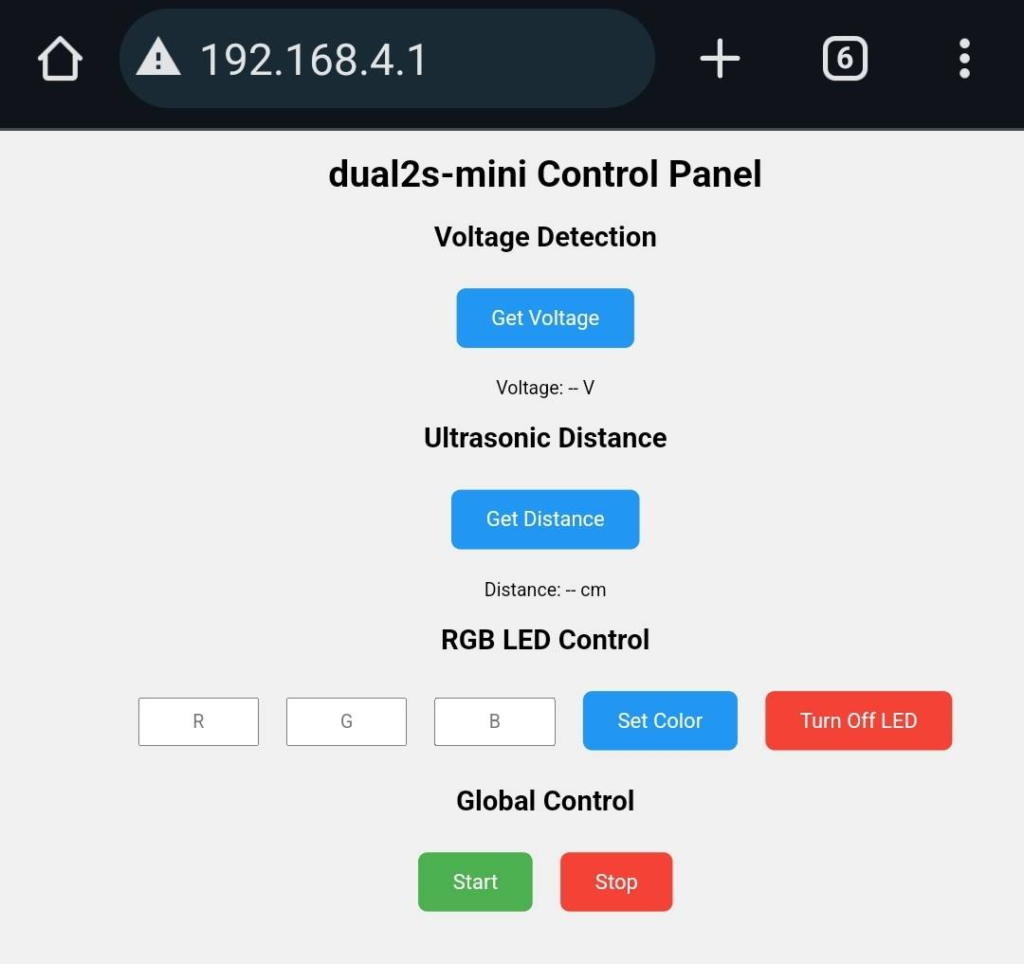How can we help you today?
【通訊】WiFi AP模式 | dual2s-mini | MPY-LLM
簡介:
AP模式(Access Point Mode)即成為一個無線接入點,使其他Wi-Fi設備可以連接並通過該設備進行通信。這種模式適合應用於無線網絡控制、物聯網設備等場景中。以下是AP模式的原理與設定方式:
AP模式的原理
- 無線網絡模式:在AP模式下,dual2s-mini會自成為無線網絡的「熱點」,並提供SSID(服務集標識符)和密碼,以便其他設備可以掃描並連接到它。
- IP分配:當ESP32/ESP8266作為無線接入點時,它會自動分配一個IP地址範圍(通常為
192.168.4.x),並將自己設為網關(默認IP為192.168.4.1)。連接的設備會在此範圍內自動獲得IP地址,形成一個局部網絡。 - 本地通信:一旦設備連接到ESP32/ESP8266的AP網絡,便可以通過這個IP範圍進行通信。這樣ESP32/ESP8266可以充當HTTP伺服器或WebSocket伺服器來處理請求,例如從網頁端發送命令,控制LED或其他外接設備。
- 安全性:AP模式可以設置Wi-Fi密碼和加密方式(例如WPA2),確保只有授權設備能夠連接。
MPY AP模式基本範例:
1.啟動AP模式
使用 network.WLAN(network.AP_IF) 來啟用AP模式。以下是基本的設置範例:
import network
import socket
# 創建 AP 物件
ap = network.WLAN(network.AP_IF)
ap.active(True) # 啟用 AP 模式
# 設定 AP 的 SSID 和密碼
ap.config(essid="dual2s_AP", password="12345678", authmode=3, channel=6, max_clients=5, hidden=False)
# 設定靜態 IP 位址
new_ip = "192.168.10.1" # 新的靜態 IP 位址
netmask = "255.255.255.0" # 子網掩碼
gateway = "192.168.10.1" # 閘道器
dns = "8.8.8.8" # DNS 伺服器
ap.ifconfig((new_ip, netmask, gateway, dns))
# 輸出設定結果
print("SSID:", ap.config("essid"))
print("認證模式:", ap.config("authmode"))
print("頻道:", ap.config("channel"))
print("最大客戶端數量:", ap.config("max_clients"))
print("IP 地址:", ap.ifconfig()[0])2. 建立簡單的Web伺服器
在AP模式下,dual2s-mini可作為伺服器來處理網頁或其他控制請求。這樣可以使用瀏覽器直接訪問dual2s-mini的IP地址來控制它。
import socket
def serve():
s = socket.socket(socket.AF_INET, socket.SOCK_STREAM)
s.bind(('', 80))
s.listen(5)
while True:
conn, addr = s.accept()
request = conn.recv(1024)
print('Received request from %s' % str(addr))
# 簡單的HTML回應
response = """<!DOCTYPE html>
<html><body><h1>dual2s-mini AP Mode!</h1></body></html>"""
conn.send('HTTP/1.1 200 OK\n')
conn.send('Content-Type: text/html\n')
conn.send('Connection: close\n\n')
conn.sendall(response)
conn.close()
# 啟動伺服器
serve()
3. 建立控制ws2812b的AP模式

import network
import socket
from machine import Pin
import neopixel
# 創建 AP 物件
ap = network.WLAN(network.AP_IF)
ap.active(True) # 啟用 AP 模式
# 設定 AP 的 SSID 和密碼
ap.config(essid="dual2s_AP", password="12345678", authmode=3, channel=6, max_clients=5, hidden=False)
# 設定靜態 IP 位址
# new_ip, netmask, gateway, dns
ap.ifconfig(("192.168.10.1", "255.255.255.0", "192.168.10.1", "8.8.8.8"))
# 輸出設定結果
print("SSID:", ap.config("essid"))
print("IP 地址:", ap.ifconfig()[0])
#----------------------------------------------------------------------------------
# HTML頁面內容
html = """
<!DOCTYPE html>
<html>
<head>
<meta charset="UTF-8">
<title>【 dual2s-mini 】</title>
<style>
body {
font-family: Arial, sans-serif;
text-align: center;
margin: 0;
padding: 0;
background-color: #f0f0f0;
}
.button {
display: inline-block;
margin: 20px;
padding: 20px 40px;
font-size: 20px;
font-weight: bold;
color: white;
border: none;
border-radius: 10px;
cursor: pointer;
}
.on {
background-color: #4CAF50; /* 綠色 */
}
.off {
background-color: #f44336; /* 紅色 */
}
.button:hover {
opacity: 0.9;
}
</style>
</head>
<body>
<h1>【 dual2s-mini 】</h1>
<h1>全彩LED ws2812b Control </h1>
<button class="button on" onclick="sendRequest('/on')">Turn ON</button>
<button class="button off" onclick="sendRequest('/off')">Turn OFF</button>
<script>
function sendRequest(path) {
fetch(path).then(response => {
console.log('Request sent to ' + path);
}).catch(error => {
console.error('Error:', error);
});
}
</script>
</body>
</html>
"""
#-------------------------------------------------------------------
# 設置WS2812B
led_pin = Pin(2, Pin.OUT)
np = neopixel.NeoPixel(led_pin, 1) # 假設只有1顆WS2812B LED
def set_led(color):
"""
控制WS2812B顏色
:param color: (R, G, B) 顏色值
"""
np[0] = color
np.write()
#----------------------------------------------------------------------------------
# 建立HTTP伺服器
def start_server():
addr = socket.getaddrinfo('0.0.0.0', 80)[0][-1]
s = socket.socket()
s.bind(addr)
s.listen(5)
print('Listening on', addr)
while True:
cl, addr = s.accept()
print('Client connected from', addr)
request = cl.recv(1024).decode('utf-8')
print('Request:', request)
# 處理GET請求
if 'GET /on' in request:
set_led((0, 255, 0)) # 綠色
elif 'GET /off' in request:
set_led((0, 0, 0)) # 關閉LED
# 回傳HTML
cl.send('HTTP/1.0 200 OK\r\nContent-type: text/html\r\n\r\n')
cl.send(html)
cl.close()
# 啟動伺服器
start_server()
4. Get命令控制超音波與全彩LED:

import network
import socket
import json
import time
from machine import Pin, time_pulse_us
import neopixel
# 創建 AP 物件
ap = network.WLAN(network.AP_IF)
ap.active(True) # 啟用 AP 模式
# 設定 AP 的 SSID 和密碼
ap.config(essid="dual2s_AP", password="12345678", authmode=3, channel=6, max_clients=5, hidden=False)
# 設定靜態 IP 位址
# new_ip, netmask, gateway, dns
ap.ifconfig(("192.168.10.1", "255.255.255.0", "192.168.10.1", "8.8.8.8"))
# 輸出設定結果
print("SSID:", ap.config("essid"))
print("IP 地址:", ap.ifconfig()[0])
#----------------------------------------------------------------------------------
# HTML頁面內容
html = """
<!DOCTYPE html>
<html>
<head>
<meta charset="UTF-8">
<title>【 dual2s-mini 】</title>
<style>
body {
font-family: Arial, sans-serif;
text-align: center;
margin: 0;
padding: 0;
background-color: #f0f0f0;
}
.button {
display: inline-block;
margin: 20px;
padding: 20px 40px;
font-size: 20px;
font-weight: bold;
color: white;
border: none;
border-radius: 10px;
cursor: pointer;
}
.on {
background-color: #4CAF50; /* 綠色 */
}
.off {
background-color: #f44336; /* 紅色 */
}
.usc {
background-color: #f44300; /* */
}
.button:hover {
opacity: 0.9;
}
</style>
</head>
<body>
<h1>【 dual2s-mini 】</h1>
<h1>Ultrasonic Distance</h1>
<p id="distance">Distance: -- cm</p>
<button class="button usc" onclick="measureDistance()">Measure</button>
<h1>全彩LED ws2812b Control </h1>
<button class="button on" onclick="sendRequest('/on')">Turn ON</button>
<button class="button off" onclick="sendRequest('/off')">Turn OFF</button>
<script>
function sendRequest(path) {
fetch(path).then(response => {
console.log('Request sent to ' + path);
}).catch(error => {
console.error('Error:', error);
});
}
async function measureDistance() {
const response = await fetch('/measure');
const data = await response.json();
const distanceElement = document.getElementById('distance');
if (data.distance >= 0) {
distanceElement.textContent = `Distance: ${data.distance} cm`;
} else {
distanceElement.textContent = "Distance: Measurement Error";
}
}
</script>
</body>
</html>
"""
#-------------------------------------------------------------------
TRIG = Pin(27, Pin.OUT)
ECHO = Pin(13, Pin.IN)
def measure_distance():
"""
啟動超聲波模組,測量距離。
回傳距離(單位:厘米)。
"""
TRIG.off()
time.sleep_us(2)
TRIG.on()
time.sleep_us(10)
TRIG.off()
# 偵測ECHO的高電平時間
duration = time_pulse_us(ECHO, 1, 30000) # 最長等待30ms
if duration < 0:
return -1 # 超時
# 計算距離(單位:cm)
distance = (duration / 2) * 0.0343
return round(distance, 2)
# 設置WS2812B
led_pin = Pin(2, Pin.OUT)
np = neopixel.NeoPixel(led_pin, 1) # 假設只有1顆WS2812B LED
def set_led(color):
"""
控制WS2812B顏色
:param color: (R, G, B) 顏色值
"""
np[0] = color
np.write()
#-------------------------------------------------------------------
# 建立HTTP伺服器
def start_server():
addr = socket.getaddrinfo('0.0.0.0', 80)[0][-1]
s = socket.socket()
s.bind(addr)
s.listen(5)
print('Listening on', addr)
while True:
cl, addr = s.accept()
print('Client connected from', addr)
request = cl.recv(1024).decode('utf-8')
print('Request:', request)
# 處理GET請求
if 'GET /on' in request:
set_led((0, 255, 0)) # 綠色
cl.send('HTTP/1.0 200 OK\r\nContent-type: text/html\r\n\r\n')
cl.send(html)
elif 'GET /off' in request:
set_led((0, 0, 0)) # 關閉LED
cl.send('HTTP/1.0 200 OK\r\nContent-type: text/html\r\n\r\n')
cl.send(html)
elif 'GET /measure' in request:
distance = measure_distance()
response = json.dumps({'distance': distance})
print('nick : ' + response)
cl.send('HTTP/1.1 200 OK\r\nContent-Type: application/json\r\n\r\n')
cl.send(response)
else:
cl.send('HTTP/1.0 200 OK\r\nContent-type: text/html\r\n\r\n')
cl.send(html)
cl.close()
# 啟動伺服器
start_server()
6. 建立控制按鍵
以下是一個完整的MicroPython程式,展示如何在ESP32的AP模式中,建立HTML網頁介面,包含以下功能:
- 按鈕觸發 電壓偵測(GPIO36)。
- 按鈕觸發 超音波模組測距(Trig=GPIO27,Echo=GPIO13)。
- 控制 全彩LED (WS2812B,GPIO2),可透過RGB文字框輸入顏色值,按下按鈕後生效。
- 啟動與停止按鈕,控制所有功能。

import network
import socket
from machine import Pin, ADC, time_pulse_us
import neopixel
import time
import json
# 硬體初始化
# 電壓偵測
adc = ADC(Pin(36))
adc.width(ADC.WIDTH_12BIT) # 設置ADC解析度為12位
adc.atten(ADC.ATTN_11DB) # 電壓範圍0-3.6V
# 超音波模組
TRIG = Pin(27, Pin.OUT)
ECHO = Pin(13, Pin.IN)
def measure_distance():
TRIG.off()
time.sleep_us(2)
TRIG.on()
time.sleep_us(10)
TRIG.off()
duration = time_pulse_us(ECHO, 1, 30000)
if duration < 0:
return -1
distance = (duration / 2) * 0.0343 # 計算距離 (cm)
return round(distance, 2)
# 全彩LED
LED_PIN = Pin(2, Pin.OUT)
np = neopixel.NeoPixel(LED_PIN, 1)
def set_led(color):
np[0] = color
np.write()
def turn_off_led():
np[0] = (0, 0, 0)
np.write()
# WiFi AP模式啟動
SSID = "ESP32_AP"
PASSWORD = "12345678"
ap = network.WLAN(network.AP_IF)
ap.active(True)
ap.config(essid=SSID, password=PASSWORD)
print("AP Mode: {} - {}".format(SSID, ap.ifconfig()[0]))
# HTML頁面
html = """
<!DOCTYPE html>
<html>
<head>
<title>ESP32 Control Panel</title>
<style>
body { font-family: Arial, sans-serif; text-align: center; background-color: #f0f0f0; }
button { margin: 10px; padding: 15px 30px; font-size: 18px; cursor: pointer; border: none; border-radius: 8px; }
button.start { background-color: #4CAF50; color: white; }
button.stop { background-color: #f44336; color: white; }
button.action { background-color: #2196F3; color: white; }
input { margin: 10px; padding: 10px; font-size: 16px; width: 80px; text-align: center; }
</style>
</head>
<body>
<h1>ESP32 Control Panel</h1>
<h2>Voltage Detection</h2>
<button class="action" onclick="fetchData('/voltage')">Get Voltage</button>
<p id="voltage">Voltage: -- V</p>
<h2>Ultrasonic Distance</h2>
<button class="action" onclick="fetchData('/distance')">Get Distance</button>
<p id="distance">Distance: -- cm</p>
<h2>RGB LED Control</h2>
<input type="text" id="r" placeholder="R" maxlength="3">
<input type="text" id="g" placeholder="G" maxlength="3">
<input type="text" id="b" placeholder="B" maxlength="3">
<button class="action" onclick="setColor()">Set Color</button>
<button class="stop" onclick="fetchData('/led?color=0,0,0')">Turn Off LED</button>
<h2>Global Control</h2>
<button class="start" onclick="fetchData('/start')">Start</button>
<button class="stop" onclick="fetchData('/stop')">Stop</button>
<script>
async function fetchData(path) {
const response = await fetch(path);
const data = await response.json();
if (path.includes('/voltage')) {
document.getElementById('voltage').innerText = `Voltage: ${data.voltage} V`;
} else if (path.includes('/distance')) {
document.getElementById('distance').innerText = `Distance: ${data.distance} cm`;
}
}
async function setColor() {
const r = document.getElementById('r').value || 0;
const g = document.getElementById('g').value || 0;
const b = document.getElementById('b').value || 0;
await fetch(`/led?color=${r},${g},${b}`);
}
</script>
</body>
</html>
"""
# 啟動HTTP伺服器
def start_server():
addr = socket.getaddrinfo('0.0.0.0', 80)[0][-1]
s = socket.socket()
s.bind(addr)
s.listen(5)
print('Listening on', addr)
running = True
while running:
cl, addr = s.accept()
request = cl.recv(1024).decode('utf-8')
print("Request:", request)
# 分析請求
if 'GET /voltage' in request:
voltage = round(adc.read() * 3.6 / 4095, 2)
response = json.dumps({'voltage': voltage})
cl.send('HTTP/1.1 200 OK\r\nContent-Type: application/json\r\n\r\n' + response)
elif 'GET /distance' in request:
distance = measure_distance()
response = json.dumps({'distance': distance})
cl.send('HTTP/1.1 200 OK\r\nContent-Type: application/json\r\n\r\n' + response)
elif 'GET /led' in request:
try:
color_str = request.split('GET /led?color=')[1].split(' ')[0]
r, g, b = map(int, color_str.split(','))
set_led((r, g, b))
except:
turn_off_led()
cl.send('HTTP/1.1 200 OK\r\nContent-Type: text/plain\r\n\r\nOK')
elif 'GET /start' in request:
running = True
cl.send('HTTP/1.1 200 OK\r\nContent-Type: text/plain\r\n\r\nStarted')
elif 'GET /stop' in request:
running = False
turn_off_led()
cl.send('HTTP/1.1 200 OK\r\nContent-Type: text/plain\r\n\r\nStopped')
else:
cl.send('HTTP/1.1 200 OK\r\nContent-Type: text/html\r\n\r\n' + html)
cl.close()
# 啟動伺服器
start_server()
